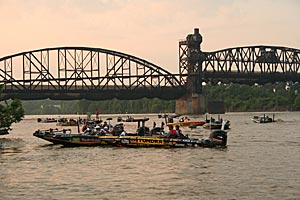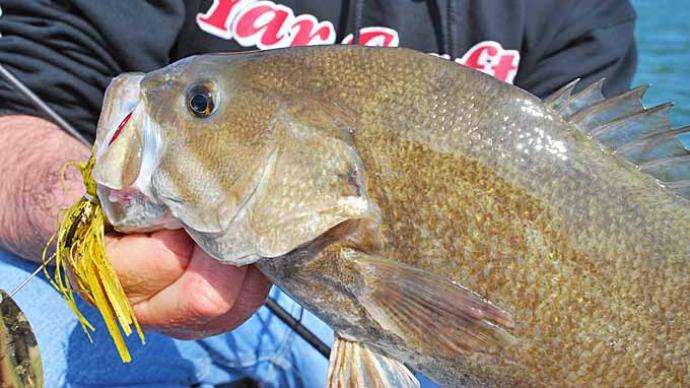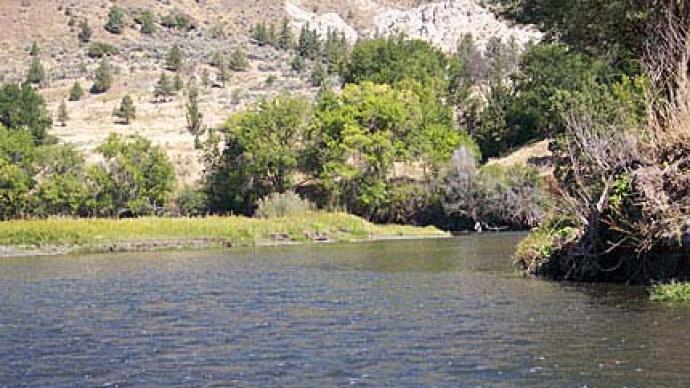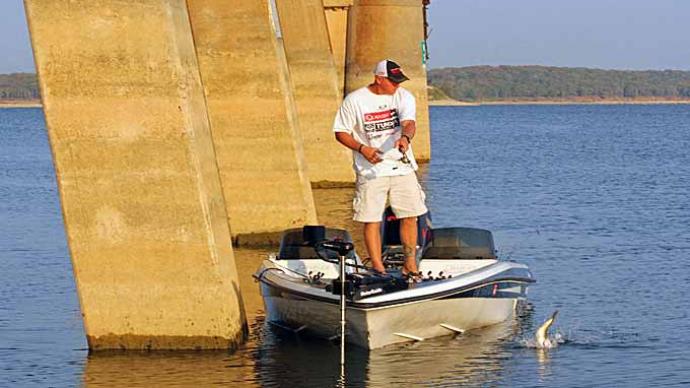
There are many theories as to how to catch bass in moving water. Opinions differ regarding location, lure type, color selection, and tidal charts. In this article, I will try to break down each component and allow you to decide for yourself what is best for your situation.
Location
Your first objective will be to eliminate as much water as possible from the fishing location. By this, I mean that you must carefully study a map of the water and perhaps spend some time on the water without fishing. This is hard to do, but it will prove "time well spent" when you locate your fish.
I like to draw a grid over a map. I draw lines one inch apart vertically, then horizontally until my map looks like a chessboard. I delete most mid-water areas and locations where the water is flowing at full speed with a pencil. Now I am looking at both shorelines with all the feeder creeks, possible deltas from other streams, or small rivers that feed into the main waterway and shoreline detail such as docks, piers, stone, or wood pilings, bridges, locks, and heavy weed growth.
In a competitive situation, I will now allocate a percentage of my allotted time to each location and fish them in practice as if I was in the tournament. Each square inch usually gets 10 minutes. If it is productive, I mark the area, note the time, and move on. I do not over-fish a location that is productive in practice. I might need those fish if a pound or two separates me from picking up a check at the end of the day! Keep moving and give yourself three of four "back-up locations." You never know when you might need them.
Lure and Color Selection
As I have often said in the past, go to local stores if you are not familiar with the color of baitfish or crawfish in the area. Then search through your tackle and try to "match the hatch."
Spinnerbaits are an excellent lure fishing with the water flow, NOT AGAINST IT! I see so many anglers throw a spinnerbait as if they were on a lake. They seem to forget that smaller fish cannot fight a tide or current and will "go with the flow." Bass are waiting for food in locations facing upstream, so cast upstream and retrieve slowly, allowing the water to "work the lure" while keeping a tight line. Do not be afraid to cast your spinnerbaits into laydowns and overhangs as you perhaps would for a jig and pork combination, as this is the perfect hideout for aggressive bass hiding in cover. Remember that cover slows down the water flow over their bodies and allows them to position for passing food. They do not want to try a fight the current and will gravitate to these locations. The cover makes their life easier and will give them more strength to attack passing bait and quickly return to their hideout to digest. Bites can be very powerful, so keep a firm grip on the rod, or you might see it disappear!
Crankbaits, both lipped and lipless, are excellent choices for moving water. The jig and pork combination will work well when cast onto the shoreline and slowly pulled into the moving water. The illusion of a crawfish being "swept away" by current is often too much for a bass to resist.
Worm, gitzit, or lizard fishing requires a heavier than usual yet still weightless finesse technique that I usually use for lake fishing. I will use a spinning outfit with 10lb test line and change a 4-inch offering for one that is 8-inches long. Upgrade your hook from a 1/0 to a 3/0 or 4/0 but remember, add no weight.
Flipping this lure into partially submerged trees, weedlines, laydowns, piers, and docks will attract attention very quickly. Allow the bait to fall naturally, watching the line at all times. With the gitzit, I like to add small pieces of Alka Seltzer or a similar product to add a bubble trail to the bait. Small twitches of the rod tip will give the appearance of something struggling to get out of the flowing water, A deadly technique that has won many tournaments in the Northeast.
Finally, I have saved the best till last. My favorite way to fish a flowing river or stream is with a topwater lure! Some of you might think I have lost my mind, but this technique is fantastic when you have cloud cover and stained water. Casting upstream and twitching the bait occasionally as it returns towards you will get some vicious strikes. Allowing the bait to drift over a likely bass hideout and then twitching the bait just as it gets over the location gives the impression of a baitfish struggling against the flow and senses danger from below. I cannot begin to tell you how exciting that strike is! You have to try it for yourself.
Tidal Movement and Charts
Tidal waters require you to obtain a tide chart. These can be obtained from local tackle stores or the local Environmental Conservation departments. Many anglers ignore these tables and fish as if they were on a lake. Their thinking is "a bass is a bass is a bass" however, I believe that river bass are hardier, more aware of their surroundings, and three times more aggressive. When the situation changes because of flow, you have to reposition also. Think about where the bass was and where it could have moved since the flow either stopped or began flowing in the opposite direction. River bass are historically nomadic, which means that they will follow baitfish up and down a stretch of river. Your objective is to locate the baitfish shoals and follow or precede them to the next cove, lay down, or shoreline contour.
Tight Lines!
Charles is a pro angler who fishes the B.A.S.S. Invitational circuit, the REDMAN Northeastern trail, and the FOXWOODS trail. He is sponsored by Bullet Weights, G.Loomis, Gamakatsu, Lake Hawk, Chevy Trucks, Hawg-ly Lures, Uncle Josh, Ike-Con Fishing Tackle, Snap-Set Spinnerbaits, Map-Trap, Stamina Components, and Power Troll Batteries.




